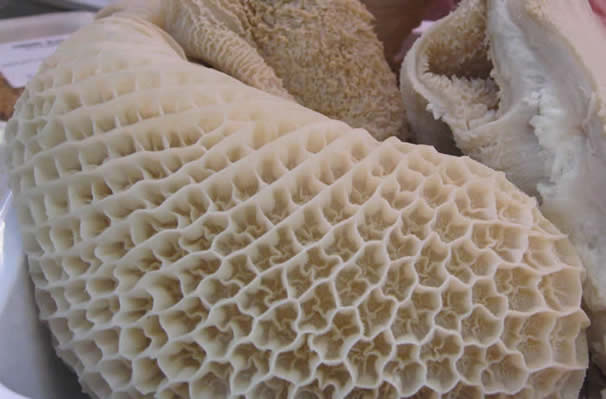OFFAL
Kidneys
Sweetbreads
Tripe

Kidneys
Lamb and veal kidneys should be cooked only very briefly or they become hard. Lamb kidney is softer that veal and I think preferable. It is also easier to remove its fatty core, which is very small. Ox kidney really needs lengthy stewing, as in steak and kidney pie.
An Italian recipe
5 fresh lamb’s kidneys or 1 small calf’s kidney
3 tablespoons olive oil
2 cloves garlic, peeled and finely chopped
2 tablespoon chopped parsley
1 heaped tablespoon flour
salt, pepper
Remove any membrane from the kidneys, cut out the fatty core and slice thinly. Put the flour in a plastic bag with a generous amount of salt and pepper, add the sliced kidneys, close the bag and shake to coat them well with the flour. Heat some oil in a frying pan and fry the kidneys gently until just coloured. Tip into a strainer and leave to drip over a bowl for 10 minutes to get rid of the bitter juices. Wipe out the pan and heat some more olive oil in it. Add the kidneys, garlic, parsley and 2 tablespoons of water. Stir and simmer gently for 2-5 minutes, and serve.
ROGNONS AUX DEUX MOUTARDES (for 2)
A very typical French recipe, although in France veal rather than lamb’s kidneys would normally be used.
5 lamb’s kidneys
1 teaspoon flour
4 tablespoons cream
1 dessertspoon French mustard
1 dessertspoon grain mustard
butter, salt, pepper
Remove any membrane from the kidneys, cut out the fatty core and slice thinly. Fry briefly in some butter until just cooked. Place to drain in a strainer over a bowl for 10 minutes to get rid of the juices. Wipe out the pan; melt some more butter and add the kidneys. Sprinkle the flour over the top and mix in well. Stir in the cream and bring to a bubble. Add the mustards, salt and pepper, stir well and serve immediately (mustard loses its pungency if cooked more than briefly).
HARICOT BEANS AND KIDNEYS (for 2)
This excellent Elizabeth David recipe was cut out of a newspaper by my mother sometime in the 1950s or 1960s. It does not appear to be in any of her books.
100-150gr haricot beans
300gr ox kidney
1 onion, peeled and sliced
1 carrot, peeled and sliced
1 teaspoon French mustard
stock
salt, pepper, allspice, bouquet garni, olive oil
Soak the beans overnight and then cook for 1-1½ hours. Cut the kidneys into smallish pieces, removing the fatty and grisly bits, and soak in tepid water while the beans are cooking. Gently fry the onion, carrot and garlic in 2 tablespoons of olive oil until soft. Stir in the drained kidney, salt, pepper and a big pinch of allspice. Pour the kidney mixture with the drained beans into an oven-proof dish, and add enough hot stock or boiling water to cover the beans. Cover the pot tightly with foil and a lid, and cook in a slow oven, gas mark 1/140° C for 3 hours. Just before serving, stir in a teaspoon of mustard. This dish freezes well, before the addition of the mustard.

********************************************
Sweetbreads
Sweetbreads can be either lamb or veal. They need to be lightly paoched and then any gristly bits removed. Purists say that you should then place them under a weight for a few hours to press them down and firm them up. I am not sure that this is really necessary with lamb's sweetbreads. Once prepared, they can be fried or reheated in a sauce. As they are rich and bland, an astringent or strong-tasting sauce is called for.
LAMB SWEETBREADS WITH SORREL AND CAPER SAUCE (for 2)
300-400gr lambs sweetbreads
big handful (40gr) of sorrel, big stalks stripped out and shredded
1 tablespoon chopped shallot
½ a small glass of wine
1 dessertspoon capers, chopped if large
1 small teaspoon flour
2 tablespoons cream
milk, cream, butter, salt and pepper
Poach the sweetbreads gently for 5-10 minutes in some well-salted water flavoured with a bouquet garni (parsley, bay-leaf, celery). Cool and remove the fatty and gristly bits (this can also be done before cooking them). Melt a dessertspoon of butter in a small saucepan and soften the shallots in it for a minute or two. Stir in the flour to make a roux. Gradually add the wine and enough milk to make a thin sauce. Reduce a little and add the sorrel. Cook until it has collapsed and lost its colour. Stir in the capers and cream and add salt and pepper to taste. Gently fry the sweetbreads in some butter until they are warmed through. Serve with the sauce poured over the top. Boiled new or waxy potatoes go well with this. The sauce also goes well with fish.

***************************************
Tripe
The cooked ox-tripe sold by English butchers has usually been cooked to within an inch of its life and is not really suitable for continental recipes that involve stewing the raw or partly cooked tripe so that it imbibes the flavours of the other ingredients. But it is good in traditional English tripe recipes such as tripe and onions. Uncooked ox and sheep tripe is available in halal butchers. Be warned, however, that tripe is smelly to cook. Sheeps tripe cooks fairly quickly, but it is thin and less good than ox tripe. The latter takes hours to become tender (it is done when you can just slice through it with a wooden spoon, but is still a bit al dente).
400 gr/1 lb cooked tripe
1-2 onions, peeled and thinly sliced
1 tablespoon butter
1 tablespoon flour
milk, nutmeg, salt and pepper
fried bread.
Slice the tripe into bite-sized pieces. Gently soften the onions in the butter, taking care not to colour them. Stir in the flour to make a roux. Gradually stir in enough milk to make a very thick paste. Add the tripe, salt, pepper and a grating of nutmeg. Cook gently for 5 minutes – the watery cooked tripe sold in England tripe normally releases enough water to thin the sauce considerably. For a luxurious touch, add some cream at the end. Serve with triangles of fried bread.

TRIPE WITH CHICK-PEAS (for 4-6)
This is based on a Spanish or Portuguese way of cooking tripe.
800gr tripe, three-quarters cooked
200gr chick-peas or white beans, cooked
2 onions, peeled and sliced
3 carrots, peeled and sliced
2-4 cloves garlic, peeled and crushed
2 tablespoons paprika
2 teaspoon ground cumin
¼ teaspoon ground cloves
500gr peeled plum tomatoes, roughly chopped
250gr streaky bacon, chopped
2½ glasses red wine
pinch chili powder
salt, pepper, thyme, bay-leaf, olive oil
Soften the onions, carrots and bacon in some olive oil. Add the spices and herbs and cook a few minutes more. Add all the other ingredients except the chick-peas or beans, and cook gently until the tripe is done. Add the chick-peas or beans and cook for a further 10-15 minutes.
TRIPE WITH BACON AND TOMATOES (for 2-3)
This is an Italian style tripe dish.
400-500 gr raw or partly cooked ox tripe
400-500 gr peeled plum tomatoes, roughly chopped
1 onion, peeled and sliced
3 cloves garlic, peeled and chopped
2-4 rashers bacon, derinded and diced
big pinch chilli powder or 1 dried red chili, chopped
olive oil, parsley, thyme (or origano), bay-leaf, salt and pepper
If the tripe is raw, boil it until three-quarters done and cut into bite-sized pieces. Melt the onion, garlic, chili and bacon in some olive oil. Add all the other ingredients and simmer gently for about ¾-1 hour, until the tripe is done.

*******************************
Tongue
Tongue is best boiled and served with a sauce.
Ox or veal tongue is sold both pickled in brine (in which case it is a strong pink colour which it retains after cooking) or fresh.
- Pickled tongue. To remove some of the salt from brined tongue, place the tongue in a saucepan of cold water, so that it is completely covered, bring to the boil and blanche (boil) for 5-10 minutes, then drain. Fill the saucepan again with cold water and added a peeled carrot and onion, a celery stick, parsley, bay-leaf, thyme and a tablespoon of peppercorns. Bring back to simmer and cook for 2½ -4 hours, until a knife can penetrate it without resistance (do not over-cook, or it will go stringy).
- Fresh tongue. Cover with cold water and bring slowly to the boil, skimming off the scum that comes to the surface. Then add the same vegetables etc as for pickled tongue, but also add 2-3 tablespoons of salt. Cook in the same way.
The tongue should then be cooled in its liquor, peeled and kept until needed (it will keep in the fridge for 3-4 days). Peeling a whole tongue is best done while it is still warm, and is usually easy for an ox-tongue. The skin on a calf’s tongue is more adherent and a bit more difficult to get off. A good trick is to cool the tongue completely (it will stiffen as it cools) and then cut it into slices (crossways) and peel the slices.
If serving the tongue cold, slice as finely as possible. It is good with anything you would normally serve with cold meats, e.g. chutney.
If serving the tongue hot, it can be sliced more thickly. Return the tongue or tongue slices to the cooking water until they are needed. The slices will also freeze well in their liquor. When you are ready to eat, simply heat the tongue or tongue slices in the liquor, drain and serve (sliced) with the chosen sauce. Tongue varies in consistency from end to end: the thick end is deliciously soft and the tip is more resistant. When slicing, therefore, it is best to cut the tongue in half crossways and give people slices from both halves.
Lambs’ tongues are sometimes available from halal butchers or shops serving a Middle-Eastern market. They are often frozen from New Zealand, but neither fresh nor cooked tongue seems to mind being frozen. Cook in the same way as for fresh ox-tongue, but only for one or two hours. Peel and serve whole with the chosen sauce. Two or three tongues per person are needed. Again, they can be frozen in their liquor.
SAUCES FOR TONGUE AND OTHER BOILED MEATS
SAUCE MADÈRE (for 2)
A traditional French sauce for hot tongue, now not often much seen. Also good with hot ham.
1 large onion, peeled and sliced
1-2 carrots, peeled and sliced
1 dessertspoon tomato purée
1 tablespoon butter
1 small tablespoon flour
3-4 tablespoons madeira, port or marsala
a little chicken stock
salt, pepper, bay-leaf
Soften the carrot and onion in some butter without letting it colour (use a small non-stick saucepan). Stir in the flour to make a roux. Then add the tomato purée and gradually stir in the stock. Cook for another 15-20 minutes and strain the sauce into a clean saucepan. Reheat and add the madeira and salt and pepper to taste.
SALSA VERDE (for 6)
Traditionally served with bollita mista, a mixture of hot boiled meats. Can be served with either hot or cold tongue. There are many versions; this is a Sienese one from Elvira Fei.
2 small hard-boiled eggs
1 tbsp capers
2 anchovy fillets (in oil)
1 large handful parsley
1 clove garlic
Olive oil, pepper
Chop the first five ingredients roughly and then put through a parsley mill. Add enough olive oil to make a creamy mixture and pepper to taste.
SAUCE RAVIGOTE (for 2)
A traditional French sauce for boiled tongue (preferably hot), brawn, calf’s head, poached brains and similar fatty meats that need a sauce with a bit of bite.
1 dessertspoon French mustard
1small dessertspoon red wine vinegar
80ml sunflower or groundnut oil
¼ of an onion (or a small shallot), peeled and finely chopped
1 teaspoon chopped capers
1 teaspoon chopped gerkins (cornichons)
Chopped parsley and tarragon
Salt, pepper
Blend together the mustard, oil, vinegar and two tablespoons of warm cooking water from the meat (or two tablespoons warm tapwater). This can be done in a blender or with one of those hand-held devices for frothing cappuccino milk. It should be almost jellied in consistency. Stir in the other ingredients and leave for half an hour or so for the flavours to develop. It will keep a day or so in the fridge.
SAUCE GRIBICHE (for 2)
Sauce gribiche is similar to sauce ravigote, but with hard-boiled egg rather than onion.
1 dessertspoon French mustard
1small dessertspoon red wine vinegar
80ml sunflower or groundnut oil
1 hard-boiled egg
1 dessertspoon chopped capers
Chopped parsley or chervil
Salt, pepper
Cut the eggs in half and remove the yolks, putting them together with the mustard. Gradually stir in the vinegar, oil and two tablespoons of warm cooking water from the meat (or two tablespoons warm tapwater), as if making a mayonnaise. Again it can be done in a blender or with with one of those hand-held devices for frothing cappuccino milk, and should be almost jellied in consistency. Then finely chop the egg-white and stir it into the sauce with the remaining ingredients. Leave for half an hour or so for the flavours to develop. It will keep a day or so in the fridge.
CAPER SAUCE (for 4)
This is the traditional English sauce for boiled mutton and other hot boiled meats.
1 small onion, peeled and fairly finely chopped
1 tablespoon butter
1 tablespoon flour
1-2 tablespoons of vinegar (the dilute vinegar from the caper bottle can be used in slightly larger quantities)
1 dessertspoon French mustard
1 teaspoon redcurrant jelly
1 tablespoon capers
3 tablespoons cream
Broth from the tongue or other boiled meat
Salt and pepper, chopped parsley
Melt the butter in a small, preferably non-stick, saucepan. Add the onion and cook gently without colouring until soft – 5-7 minutes. Stir in the flour to make a roux and then gradually stir in hot broth from the tongue (or other hot stock), to make a sauce of creamy consistency. Add the vinegar, mustard and redcurrant jelly and cook for a few minutes more, whisking until smooth. Add the capers, cream, parsley and salt and pepper to taste, bring back briefly to a simmer and serve poured over the hot sliced tongue.